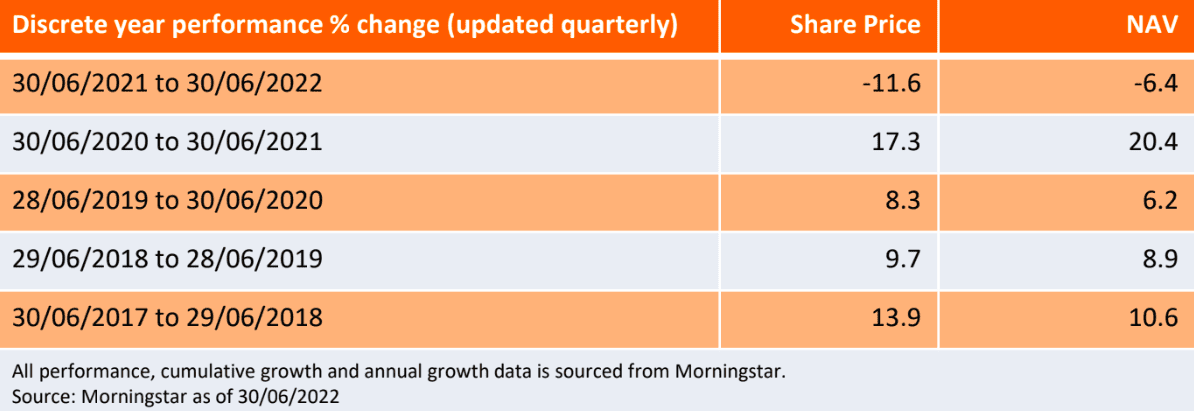The Bankers Investment Trust Fund Manager Commentary – Q2 2022

6 minute read
Key takeaways:
Au
Alex Crooke, Portfolio Manager of The Bankers Investment Trust, provides an update on Trust, highlighting the key drivers/detractors of performance over the quarter and recent portfolio activity. Alex also provides his outlook for markets in the coming months.
Macro backdrop
Uncertainty remained the overriding mood in global equity markets during the three months to 30 June. While that caused further bouts of weakness in share prices, it also provided an opportunity for the Bankers Investment Trust to exhibit its relative resilience. Evidence of that was the Trust’s outperformance against its benchmark index. The net asset value ended the period 6.75% lower, while the FTSE World Index was down 9.07%.¹
The war in Ukraine was among the market’s major concerns. Initially we did not anticipate a full invasion by Russia and this was not modelled into our strategy. The initial impact of the war was on the cost of energy which, in turn, had a knock-on effect for raw materials and food prices. Stocks were also hit by the effects of rising inflation on household spending, while several companies struggled with the lingering effects of Covid and faltering supply chains. The surging inflation and consequent rise in interest rates have troubled markets over recent months so, in some respects, the weakness in share prices was to be expected.
While these features generally dampened enthusiasm among investors, there were reasons for optimism. For example, China was a strong performer as the market there rallied from extreme weakness earlier this year. That more upbeat tone stemmed from the easing of Covid lockdowns and implementation of loose monetary policy. The improving sentiment enabled the China CSI300 index to deliver a double-digit positive return over the quarter.
Trust performance and activity
Against the uncertain backdrop, Bankers Investment Trust performed relatively well. In anticipation of the conditions we are now experiencing, we had taken some action in previous quarters. For example, we reduced exposure to some Asian markets, and had sought out higher quality businesses with dependable earnings. Rising inflation has been on our radar for some time, fueled by factors such as the lack of mobility in the workforce due to Covid restrictions. An uncertain situation has become even more fluid with the added inflationary impact of energy and food.
With this in mind, we have been paying particular attention to companies that satisfy demand for non-discretionary purchases. Our aim is to find price-makers rather than price-takers -companies that produce goods and are the low-cost provider -as they should prosper, relatively speaking.
We believe that diversification of the fund is now more important than ever. The Trust benefits from our ability to invest in any geographic region and sector, with no limits on individual country or sector exposures. We see this as an important aspect of helping our shareholders to enjoy stable and consistent returns. We have assets in various parts of the world and do not take extreme views.
The fund has invested in China-listed companies for around eight years. Although we cut back our exposure in 2021, we retained some of the weighting. That paid off during the quarter when there was some optimism that China is beginning to soften the zero-Covid approach to help the economy move forward. There was also positive news on regulation easing up in key sectors of the economy.
Other key drivers included our overweight position in the UK, relative to the benchmark. This helped to differentiate our fund from many of its peers which tended to have less UK exposure, and that boosted relative performance.
In terms of individual stocks, holdings such as AstraZeneca in the healthcare sector, and British American Tobacco in consumer staples helped to drive positive performance. There were also helpful contributions from the energy company TotalEnergiesin Europe, and the telecommunications provider American Tower in the US. Both showed resilience during the wider market sell-off and the latter proved to be the best performer in the portfolio.
In contrast, underweight positions in basic materials, energy and utilities all detracted from returns. However, the damage was limited when these sectors reversed their gains late in the quarter.
Outlook/strategy
In periods of economic uncertainty, the drivers of performance are often more sector or market decisions rather than anything relating to individual stocks. We are seeing the emergence of some opportunities to reallocate capital into markets where we expect higher growth to occur over the next two years.
We continue to place a great deal of emphasis on the trust’s ability to use global markets to diversify risk. We see better value in Asia and we are looking to cautiously increase exposure there. We previously reduced our exposure to US technology stocks and have switched our focus to areas which deliver dependable growth. This is more about blending value and growth rather than any change of investment approach. China will probably look to expand its economy by cutting rates or expanding monetary policy, whereas other markets are likely to be raising rates and seeing higher inflation. This should benefit stocks both within the Chinese market and the broader Asia region.
The current outlook remains uncertain given upward pressure on interest rates, as we do not know how high they may go or what effect that will have on inflation. In addition, we are cautious on Ukraine, so portfolio construction is driven by where we see better opportunities -the best growth for the best value.
¹Source: Bloomberg as at 30 June 2022.
Diversification – A way of spreading risk by mixing different types of assets/asset classes in a portfolio. It is based on the assumption that the prices of the different assets will behave differently in a given scenario. Assets with low correlation should provide the most diversification.
Growth investing – Growth investors search for companies they believe have strong growth potential. Their earnings are expected to grow at an above-average rate compared to the rest of the market, and therefore there is an expectation that their share prices will increase in value.
Inflation – The rate at which the prices of goods and services are rising in an economy. The CPI and RPI are two common measures.
Monetary policy – The policies of a central bank, aimed at influencing the level of inflation and growth in an economy. It includes controlling interest rates and the supply of money. Monetary stimulus refers to a central bank increasing the supply of money and lowering borrowing costs. Monetary tightening refers to central bank activity aimed at curbing inflation and slowing down growth in the economy by raising interest rates and reducing the supply of money.
Value investing – Value investors search for companies that they believe are undervalued by the market, and therefore expect their share price to increase. One of the favoured techniques is to buy companies with low price to earnings (P/E) ratios.



